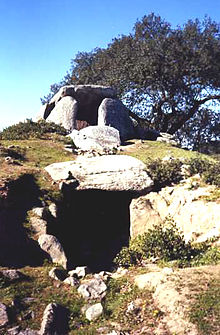Great Dolmen of Comenda da Igreja
 | |
 Location of the dolmen in the municipality of Montemor-o-Novo | |
| Alternative name | Great Dolmen of the Military Order of the Estate |
|---|---|
| Location | Évora, Alentejo Central, Alentejo, Portugal |
| Coordinates | 38°45′29″N 8°12′12″W / 38.7579844°N 8.2032034°W |
| Altitude | 180 m (591 ft) |
| Type | Dolmen |
| Length | 15.00 m (49.21 ft) |
| Width | 4.00 m (13.12 ft) |
| Site notes | |
| Archaeologists | unknown |
| Ownership | Portuguese Republic |
| Public access | Private Estrada Nacional EN2 (Montemor-o-Novo-Mora), approximately 2 kilometres (1.2 mi) before São Geraldo, over a small bridge, first left turn: the dolmen is located 400 metres (1,300 ft) from the EN2, along this roadway |
The Great Dolmen of Comenda da Igreja (Portuguese: Anta Grande de Comenda da Igreja, or alternately Anta Grande da Herdade da Igreja) is a megalithic funerary site in the civil parish of Nossa Senhora do Bispo, in the municipality of Montemor-o-Novo, in the central Alentejo region of continental Portugal.
History
[edit]Between the 4th millennium BC and the middle of the 3rd millennium BC, the site of was occupied by semi-nomadic or sedentary settlement, associated with the communities of ancient Évora.[1][2]
Architecture
[edit]The megalithic site, is located in an isolated area of forested brush, situated in an area of plains.[1]
Its form extends longitudinally from west to east, composed of a central polygonal chamber roughly 4 metres (13 ft) wide, with an oblong rectangular corridor 10 metres (33 ft) long.[1][2]
The articulated volumes are oriented horizontally, and covered independently in each section, with the main chamber covered by a granite slab, and the corridor by individual elements.[1] The walls of the chamber are 6 metres (20 ft) in height, while the corridor profile is 180 centimetres (71 in) in height.[1] Of great dimensions, the corridor is still intact and in a state of conservation.[1][2]
References
[edit]- Notes
- ^ a b c d e f Branco, Manuel; Nunes, Castro (1994). SIPA (ed.). "Anta Grande da Comenda da Igreja/Anta Grande da Herdade da Comenda (n.PT040706030007)" (in Portuguese). Lisbon, Portugal: SIPA–Sistema de Informação para o Património Arquitectónico. Retrieved 25 June 2012.
- ^ a b c Martins, A. (2011). IGESPAR (ed.). "Anta grande da Comenda da Igreja" (in Portuguese). Lisbon, Portugal: IGESPAR – Instituto de Gestão do Património Arquitectónico e Arqueológico. Archived from the original on 13 January 2013. Retrieved 22 June 2012.
- Sources
- Gonçalves, José Pires (1975), Roteiro de alguns Megálitos da Região de Évora (in Portuguese), Évora, Portugal
{{citation}}: CS1 maint: location missing publisher (link) - Leisner, Georg (1949), "Antas dos arredores de Évora", A Cidade de Évora (in Portuguese), Évora, Portugal
{{citation}}: CS1 maint: location missing publisher (link) - Leisener, Georg; Leisner, Vera (1956), "Die Megalitgraber der Iberischen Halbinsel I – Der Westen", Madrider Forschungen (in German), vol. I, Madrid, Spain
{{citation}}: CS1 maint: location missing publisher (link)
